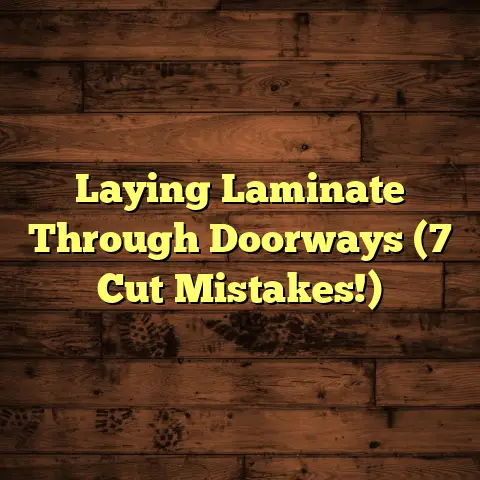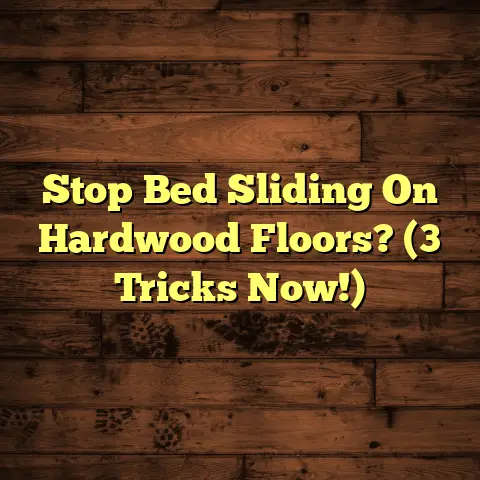Refinishing Wood Floors: Cost Guide (2 Day DIY?)
(Image: A striking before-and-after photo showcasing a heavily scratched and dull wood floor next to a gleaming, newly refinished wood floor.)
As a flooring contractor, I’ve seen it all – from floors buried under decades of carpet to water-damaged nightmares. But nothing beats the satisfaction of bringing a tired wood floor back to life.Wood floor refinishing isn’t just about aesthetics; it’s about preserving your home’s value and creating a warm, inviting space. In this article, I’ll walk you through everything you need to know about refinishing your wood floors, from costs to the DIY approach and whether you can really do it in two days. Let’s dive in!
Understanding Wood Floor Refinishing
So, what is wood floor refinishing? Simply put, it’s the process of removing the old finish, smoothing out imperfections, and applying a new protective layer.
Why do people do it? Well, scratches, dents, and a worn-out finish can make even the most beautiful wood floors look sad. Refinishing restores their natural beauty and protects them from further damage.
Solid Hardwood vs. Engineered Wood
Not all wood floors are created equal. The big question is: Do you have solid hardwood or engineered wood?
-
Solid Hardwood: This is the real deal – planks made from a single piece of wood. It can be sanded and refinished multiple times, making it a long-term investment. Think oak, maple, walnut, etc.
-
Engineered Wood: This consists of a thin layer of hardwood veneer glued to a plywood or fiberboard core. It’s more dimensionally stable than solid hardwood, but it can only be refinished a limited number of times (or sometimes not at all, depending on the thickness of the veneer).
How do you tell the difference? Look at the edges of the floor, especially near vents or doorways. Solid hardwood will have a consistent grain pattern throughout, while engineered wood will show the layered construction. If you’re unsure, consult a flooring professional.
Refinishing Process: Step-by-Step
Okay, let’s break down the refinishing process:
- Preparation: Clear the room, remove baseboards, and protect anything you don’t want covered in dust. This is crucial.
- Sanding: This is where you remove the old finish and smooth out any imperfections. It typically involves using different grits of sandpaper, starting with a coarse grit and working your way to a fine grit.
- Staining (Optional): If you want to change the color of your floors, now’s the time. Apply the stain evenly and wipe off the excess.
- Sealing: Apply a sealant to protect the wood and provide a base for the finish.
- Finishing: Apply several coats of finish (polyurethane is common), allowing each coat to dry completely before applying the next.
- Curing: Allow the finish to cure completely before moving furniture back into the room.
Each step is critical. Skimping on sanding or applying the finish unevenly can lead to a less-than- perfect result.
Cost Breakdown of Refinishing Wood Floors
Alright, let’s talk money. Refinishing wood floors can be a significant investment, but it’s almost always worth it. Here’s a breakdown of the costs involved:
A. Labor Costs
Hiring professionals will always be more expensive than doing it yourself. But let’s be honest, it’s also a lot easier.
-
Average Labor Costs: Expect to pay anywhere from $3 to $8 per square foot for professional refinishing. This can vary depending on your location, the complexity of the job, and the contractor you choose.
-
DIY vs. Professional: The obvious advantage of DIY is the cost savings. You’ll save on labor, but you’ll need to invest your time and effort. The trade-off is that professional can guarantee quality of work.
Example: Let’s say you have a 500-square-foot room. Professional refinishing could cost you between $1,500 and $4,000. DIY could cost you between $300 and $800 in materials, but you’ll be sweating it out for a few days.
B. Material Costs
Here’s a detailed list of materials you’ll need for a DIY refinishing project, along with approximate costs:
| Material | Approximate Cost (per sq ft) | Notes |
|---|---|---|
| Sander Rental | \$30-50 per day | You’ll need a drum sander for the main sanding and an edger for the edges of the room. |
| Sandpaper (Various Grits) | \$20-40 | Start with a coarse grit (36-40) to remove the old finish, then move to medium (60-80) to smooth out imperfections, and finish with a fine grit (100-120) for a smooth surface. |
| Wood Stain | \$20-50 per quart | Choose a stain that complements your home’s décor. Oil-based stains are generally more durable, but water-based stains are lower in VOCs. |
| Wood Finish (Polyurethane) | \$30-60 per gallon | Polyurethane is a durable, water-resistant finish that’s perfect for wood floors. Choose between oil-based and water-based options. Oil-based polyurethane is more durable but has a stronger odor and longer drying time. |
| Sealant/Primer | \$20-40 per gallon | A sealant or primer helps the finish adhere to the wood and provides an extra layer of protection. |
| Tack Cloth | \$5-10 | Use a tack cloth to remove dust particles between sanding and finishing. |
| Safety Gear | \$20-50 | This includes a respirator mask, safety glasses, and ear protection. Don’t skimp on safety! |
| Applicators (Brushes, Rollers) | \$10-20 | Invest in high-quality brushes and rollers for applying stain and finish. |
Budget-Friendly vs. High-End Materials:
You can save money by opting for budget-friendly materials, but it’s important to consider the trade-offs. Cheaper stains and finishes may not be as durable or long-lasting. I always recommend investing in quality materials for a better, longer-lasting result.
C. Additional Expenses
Don’t forget about these potential additional costs:
- Repairs: If your floors have damaged boards, you’ll need to repair or replace them before refinishing. This can add significant cost, depending on the extent of the damage.
- Tool Rental: If you don’t own a sander, you’ll need to rent one. Prices vary depending on the type of sander and the rental period.
- Disposal Fees: You may need to dispose of old finish, stain cans, and other waste materials properly. Check with your local waste management facility for regulations and fees.
- Unexpected Expenses: Always budget for the unexpected. You might discover hidden damage, need extra materials, or encounter other unforeseen issues.
Budgeting for Unexpected Expenses:
I always recommend adding a 10-15% buffer to your budget to cover unexpected expenses. It’s better to be safe than sorry!
DIY Refinishing: A 2-Day Plan
Okay, so you’re feeling brave and want to tackle this project yourself. Can you really refinish your wood floors in two days? It’s ambitious, but with careful planning and hard work, it’s possible.
Disclaimer: This is an aggressive timeline. Be prepared for long days and potential setbacks. If you’re not comfortable with a fast-paced project, consider spreading it out over three or four days.
A. Preparation
Tools and Materials Checklist:
- Drum sander
- Edger sander
- Sandpaper (various grits)
- Wood stain
- Wood finish (polyurethane)
- Sealant/Primer
- Tack cloth
- Respirator mask
- Safety glasses
- Ear protection
- Brushes and rollers
- Paint trays
- Drop cloths
- Putty knife (for repairs)
- Hammer (for repairs)
- Wood filler (for repairs)
- Vacuum cleaner
- Shop-Vac
- Mineral spirits (for cleaning brushes)
Step-by-Step Preparation Guide:
- Clear the Room: Remove all furniture, rugs, and other obstacles. This is essential for safe and efficient sanding.
- Remove Baseboards: Carefully remove the baseboards using a pry bar. Label them so you know where they go when you reinstall them.
- Assess the Floor: Inspect the floor for damage, such as loose boards, cracks, or water stains. Address these issues before sanding.
- Gather Supplies: Make sure you have all the necessary tools and materials on hand before you start. There’s nothing worse than running to the store in the middle of a project.
- Protect the Area: Cover any areas you don’t want covered in dust with drop cloths. Seal off doorways and vents to prevent dust from spreading to other parts of your home.
B. Day 1: Sanding and Staining
Sanding Process in Detail:
- Safety First: Put on your respirator mask, safety glasses, and ear protection. Sanding creates a lot of dust, and you don’t want to breathe it in or get it in your eyes.
- Start with Coarse Grit: Load the drum sander with a coarse grit sandpaper (36-40). Sand the entire floor in the direction of the wood grain, overlapping each pass by about 50%.
- Edge the Room: Use the edger sander to sand the edges of the room, where the drum sander can’t reach. Be careful not to gouge the floor.
- Move to Medium Grit: Switch to a medium grit sandpaper (60-80) and repeat the sanding process. This will smooth out the floor and remove any scratches left by the coarse grit.
- Finish with Fine Grit: Switch to a fine grit sandpaper (100-120) and repeat the sanding process one last time. This will create a smooth, even surface for staining.
- Vacuum Thoroughly: Vacuum the entire floor to remove all dust and debris. Use a Shop-Vac to get into the corners and crevices.
- Tack Cloth: Wipe the floor with a tack cloth to remove any remaining dust particles.
Choosing and Applying Stain:
- Choose the Right Stain: Consider your home’s décor and the overall look you’re trying to achieve. Test the stain on a small, inconspicuous area of the floor to make sure you like the color.
- Apply the Stain Evenly: Use a high-quality brush or roller to apply the stain evenly to the floor. Work in small sections and follow the manufacturer’s instructions.
- Wipe Off Excess Stain: After allowing the stain to sit for the recommended amount of time, wipe off the excess with a clean cloth. This will prevent the stain from becoming too dark or blotchy.
- Allow to Dry Completely: Allow the stain to dry completely before moving on to the next step. This can take anywhere from 4 to 24 hours, depending on the type of stain and the humidity levels.
C. Day 2: Sealing and Finishing
Applying Sealant and Finishing Coats:
- Apply Sealant: Apply a thin, even coat of sealant to the floor using a brush or roller. Allow it to dry completely according to the manufacturer’s instructions.
- Apply First Coat of Finish: Apply a thin, even coat of polyurethane to the floor using a brush or roller. Work in small sections and follow the manufacturer’s instructions.
- Allow to Dry Completely: Allow the first coat of finish to dry completely before applying the next coat. This can take anywhere from 4 to 24 hours, depending on the type of finish and the humidity levels.
- Lightly Sand Between Coats: Lightly sand the floor with a fine-grit sandpaper (220-grit) between coats of finish. This will help to create a smooth, even surface.
- Apply Second and Third Coats: Apply two more coats of polyurethane, allowing each coat to dry completely before applying the next.
Ventilation and Safety:
- Ventilate the Area: Open windows and doors to provide adequate ventilation. This will help to reduce the odor from the stain and finish and prevent the build-up of harmful fumes.
- Wear a Respirator Mask: Continue to wear a respirator mask throughout the sealing and finishing process to protect yourself from harmful fumes.
- Avoid Open Flames: Keep open flames and sparks away from the area while working with stain and finish. These materials are highly flammable.
Conclusion
Refinishing wood floors is a rewarding project that can transform the look and feel of your home. While it requires time, effort, and a bit of skill, the results are well worth it.
Cost Savings and Satisfaction:
DIY refinishing can save you a significant amount of money compared to hiring professionals. Plus, there’s a certain satisfaction that comes with knowing you did it yourself.
Is Refinishing Right for You?
Assess the condition of your floors and consider your budget, skills, and time constraints. If you’re up for the challenge, DIY refinishing can be a great way to save money and add value to your home. If not, hiring a professional is always a good option.
No matter which route you choose, refinishing your wood floors is a worthwhile investment that will bring beauty and warmth to your home for years to come. So, what are you waiting for? Get started today!





